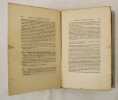-
Type
Book (1764)
Drawings (7)
Magazine (23)
Music sheets (8)
-
Latest
Last 24h (3)
Last 3 days (15)
Last month (29)
Last week (2)
-
Language
Albanian (1)
French (1798)
Greek (1)
Italian (1)
Russian (1)
-
Century
16th (1)
19th (22)
20th (943)
21st (59)
-
Countries
Belgium (67)
Canada (34)
Côte d'Ivoire (5)
Denmark (1)
France (1465)
Germany (21)
Italy (12)
Switzerland (195)
United Kingdom (1)
United States of America (1)
-
Syndicate
ALAC (21)
CLAM (17)
CLAQ (11)
CNE (3)
ILAB (694)
NVVA (27)
SLACES (27)
SLAM (580)
SNCAO (1)
La revue blanche, tome XXIX, n°228
Editions de la revue blanche La revue blanche Broché 1902 In-8 (16x25 cm), broché, tome XXIX n°228 de la revue bi-mensuelle 'La Revue blanche', 1er décembre 1902, 13e année, contient l'édition originale de 'L'Ermite' d'Apollinaire et un texte d'Alfred Jarry ; dos jauni, coiffes frottées, rousseurs sur les bords du premier plat, bon état. Livraison a domicile (La Poste) ou en Mondial Relay sur simple demande.
"(Collection : ""Bibliothèque Privée"")"
L'Or du Temps. 1969. In-8. Relié. Bon état, Couv. convenable, Dos satisfaisant, Intérieur frais. 246 + CXX pages. Quelques planches d'illustrations en noir et blanc en fin d'ouvrage. Signet conservé.. . . . Classification Dewey : 94.41-Editions numérotées (gros tirage)
"Collection : ""Bibliothèque Privée"". Exemplaire n°2954 sans justificatif de tirage. Classification Dewey : 94.41-Editions numérotées (gros tirage)"
Guillaume Apollinaire. Préface de Philippe Soupault.
P., Librairie Seguier (Collection "Vagabondages"), 1986, in 8° broché, 197 pages ; couverture illustrée ; importante iconographie.
PHOTOS sur DEMANDE. ...................... Photos sur demande ..........................


Phone number : 04 77 32 63 69
Oeuvres complètes de Guillaume Apollinaire. Edition établie sous la direction de Michel Décaudin.
Préface de Max-Pol Fouchet. Introduction et notes de Michel Décaudin. Iconographie établie par Marcel Adéma. Paris : André Balland / Jacques Lecat, 1965-1966. 4 volumes 14,5x22,5cm en reliures d'éditeur ornées de calligrammes, tête dorée. 751 + 829 + 946 + 975 pages sur papier vergé, illustrées de reproductions dans et hors texte + 4 emboitages contenant 34 documents en fac-similé, réalisés par Daniel Jacomet. Edition originale collective tirée à 5500 exemplaires ("n°2280"). Bon état.
Tome I : L'Enchanteur pourrissant. L'Hérésiarque et Cie. La Femme assise. Le Poète assassiné. Contes retrouvés. Tome II : Anecdotiques. Le Flâneur des deux Rives. Les Diables amoureux. Chroniques. Préfaces. Tome III : Alcools. Calligrammes. Poésie. Théâtre. Critique. Tome IV : Les Peintres cubistes.Chroniques d'art. Correspondance.
APOLLINAIRE, Guillaume. - DECAUDIN, Michel (sous la direction de).
Reference : 118607
Oeuvres complètes de Guilluame Apollinaire. Edition établie sous la direction de Michel Décaudin.
Paris, André Balland et Jacques Lecat 1965 -1966 255x160mm, broché. En feuille sous couverture rempliée et étuis. Réalisé sous la direction artistique et technique de Pierre Faucheux, composé en Baskerville corps 10 et 9 et tiré sur papier vergé, a été achevé d'imprimer le 31 août 1966 par l'Imprimerie Centrale, à Lausanne, et relié par Engel. Les fac-similés ont été réalisés par Daniel Jacomet. L’édition a été limitée à 5 500 exemplaires. En outre, 480 exemplaires, constituant l’édition de tête, ont été tirés sur Arches. Exempaire de tête sur papier Arches, numéroté n.° 195 / 480. Très bel exemplaire.
Pour un paiement via PayPal, veuillez nous en faire la demande et nous vous enverrons une facture PayPal
Lettre autographe signée à l'éditeur Pierre Aelberts.
Longue lettre autographe signée et datée du 22 décembre 1954. Il écrit à Pierre Aelberts pour lui demander un exemplaire de ses plaquettes Brimborions sur Apollinaire, Airelles et Lettres à Jeanne. Il lui demande la possibilité d’en acheter un exemplaire ou qu’Aelberts les donne à l’Association devenant alors membre (d’honneur ou protecteur). Il en profite pour évoquer l’Association des amis de G. Apollinaire et lui adresse copie de la lettre d’origine expliquant les buts et statuts de l’Association. Une page in-8 recto verso complétée d’un document de deux pages in-8 recto verso.
L'enchanteur pourrissant
LCL LCL, 1971. In-8 carré relié pleine toile éditeur de 85 pages illustrées par Derain. Tirage limité numéroté à 3000 exemplaires, celui-ci non justifié. Très bon état
Toutes les expéditions sont faites en suivi au-dessus de 25 euros. Expédition quotidienne pour les envois simples, suivis, recommandés ou Colissimo.
Tendre comme le souvenir.
Gallimard NRF Paris 1952 In-12 ( 185 X 125 mm ) de 354 pages, plein maroquin brique à grains longs, dos à nerfs janséniste avec date dorée en queue, tête dorée, couverture et dos conservés ( Reliure signée de DEVAUCHELLE ). Edition originale. Tirage à 1520 exemplaires numérotés, celui-ci un des 400 exemplaires sur vélin pur fil Lafuma-Navarre, numérotés de 71 à 470 ( après 2 sur Japon, 27 sur Madagascar, et 61 sur vergé de Hollande ). Dos légèrement éclairci, bel exemplaire dans une fine et élégante reliure signée de DEVAUCHELLE.
Le Poète assassiné
Paris, Au sans pareil, 1926. In-folio, 147 pp., maroquin rouge mosaïqué de maroquin noir de René Kieffer, filets dorés sur les plats, dos long, bordure intérieure orné de filets dorés, tête dorée, couverture conservée, étui bordé (dos légèrement foncé, mors restaurés).
Édition illustrée de 36 lithographies en noir de Raoul Dufy. Un des 580 exemplaires sur vélin Montgolfier d'Annonay. Ex-libris Guy Seligmann, étiquette du relieur René Kieffer. Bel exemplaire dans une jolie reliure de René Kieffer. * Membre du SLAM et de la LILA / ILAB Member. La librairie est ouverte du lundi au vendredi de 14h à 19h. Merci de nous prévenir avant de passer,certains de nos livres étant entreposés dans une réserve.
GUILLAUME APOLLINAIRE - ALCOOLS.
Société d'Edition d'Enseignement Supérieur. 1956. 3 tomes en 3 volumes in-12 brochés. 315, 262 & 246 pages.
Cours faits en Sorbonne de 1954 à 1956. Bon état.
Guillaume Apollinaire, Alcools. Tome III.
1964 Paris, Société d'Edition d'Enseignement Supérieur, 1964, in 12 broché, 247 pages ; index des noms de personnes et des références aux pièces d'alcools ; piqûres à la couverture.
...................... Photos sur demande ..........................


Phone number : 04 77 32 63 69
Guillaume Apollinaire. Alcools. Tomes 1 à 3.
SEDES 1956 3 vol. broché Tomes 1 à 3 (publiés en 1956 et 1964). 3 vol. in-12, brochés, 315, 262 et 246 pp., bibliographie et index. Beaux envois de l'auteur à Pierre Clarac dans les deux premiers volumes. Couverture du tome 1 un peu salie, sinon l'ensemble en bon état.
APOLLINAIRE. Introduction de Philippe Soupault.
Librairie Séguier. 1986. Grand in-8° broché. Couverture illustrée. Nombreux documents et photographies. 197 pages. E.O.
Très bon état.
LE DOSSIER D« ALCOOLS ». Edition annotée des pré-originales, avec une introduction et des documents ».
Genève. Droz. 1996. Grand in-8° br. 242 pp. 3e édition, revue.
Bon état. Exemplaire de Jean-Jacques Pauvert comportant son cachet d'ex-libris. Note de Jean-Jacques Pauvert au crayon sur la page de garde.
Apollinaire Guillaume Décaudin Michel Derain André
Reference : 500095709
(2006)
ISBN : 9782070319480
L'Enchanteur pourrissant suivi de "Les Mamelles de Tirésias" et de "Couleur du temps"
Gallimard 2006 246 pages poche. 2006. Broché. 246 pages.
Bon état
Etudes et informations réunies par Michel Décaudin
La Revue des lettres modernes, 1962 1973 13 volumes in-12 broché, plus de 2500 pp. Quelques illustrations hors-texte en noir. Bon exemplaire. Nous joignons 4 numéros de la série des Archives Guillaume Apollinaire : n 1, 3, 5 & 6 publiés entre 1969 et 1972.
Rare réunion de cette publication annuelle entreprise par Décaudin. Etudes et chroniques d’actualité. Contributions : Marguerite Bonnet ; M. Sanouillet ; P.-M. Adéma ; M. Poupon ; L.-C. Breunig. etc. Actualité apollinienne, bibliographies... Bon état d’occasion
Les exploits d'un jeune Don Juan. Roman.
Société nouvelle des éditions Pauvert, 1992. In-8, cartonnage noir, titre doré au dos et au premier plat. En belle condition.
Apollinaire Guillaume ; Décaudin Michel (sous la direction de) ; Fouchet Max-Pol (préface) ; Adéma Marcel (iconographie)
Reference : 9366
(1966)
Oeuvres complètes de Guillaume Apollinaire
André Balland et Jacques Lecat 1966 Maquette de Pierre Faucheux composée en Baskerville corps 10 et tirée sur papier vergé. 4 volumes de textes + 4 coffrets de documents fac-similés réalisés par Daniel Jacomet. In-4 reliure éditeur pleine peau verte. Dos lisses avec titres dorés, premiers plats avec motifs calligraphiques dorés. Têtes dorées. 22,7 cm sur 14,3. 751-828-946-975 pages + 34 fac-similés de photographies, cartes postales, portraits, lettres, carte de visite et extrait de quotidien. Illustrations en noir et blanc hors-texte. Notes, table des illustrations. Dos du tome 4 avec légers frottements, traces d’humidité sur les contreplats des coffrets sinon ensemble en bon état d’occasion.
Tome 1 : L’Enchanteur pourrissant. L’Hérésiarque et Cie. La Femme assise. Le Poète assassiné. Contes retrouvés. Tome 2 : Anecdotiques. Le Flâneur des deux rives. Les Diables amoureux. Chroniques. Préfaces. Tome 3 : Alcools. Calligrammes. Poésie. Théâtre. Critique. Tome 4 : Les Peintres cubistes. Chroniques d’art. Tendre comme le souvenir. Correspondance Bon état d’occasion
La Rome des Borgia.
Envoi autographe signé Paris, Bibliothèque des curieux, 1913. 1 vol. (140 x 225 mm) de 301 p., [2] f. et 1 f. Demi-maroquin vert à coins, dos à nerfs, titre doré, tête dorée, couverture et dos conservés (Reliure signée de Goy et Vilaine). Édition originale, ornée de 10 hors textes. Envoi signé : « À Monsieur Georges Bonnamour son admirateur depuis longtemps. Guillaume Apollinaire ».
L'édition fut composée avec René Dalize, poète d'origine créole né à Paris en 1879 et fondateur avec Apollinaire de la revue Les Soirées de Paris. Les deux poètes explorent les possibilités du mal par la décomposition morale caractéristique d'un pouvoir total - celui du Prince - qui suffit à suggérer l'effroi. « Le manuscrit de la Rome des Borgia, qui est de l'Histoire romanesque, nous a été remis par la veuve d'un illustre historien [...]. Nous y avons joint un certain nombre de documents qui ne peuvent qu'augmenter l'intérêt historique d'un livre qui n'est nullement dirigé contre la religion ni contre ses ministres, mais relate simplement des moeurs très différents des autres », avertit Apollinaire. Et de nous transporter dans la capitale de la Renaissance au temps du règne d'Alexandre VI, à l'époque la plus violente et la plus raffinée de cette période. Ce roman historique, où Sade complète Dumas, évoque sans tout à fait les décrire les turpitudes, crimes et abus d'un univers clos par la puissance, celle des Borgia, de leurs orgies, incestes et de leur usage immodéré du fameux poison qu'ils avaient inventé, la cantarella, associé à l'arsenic. Un catalogue d'abominations qui annonce le théâtre de la cruauté, dont Antonin Artaud situera également un exemple dans l'Italie renaissante. Dalize, à qui sera dédié Calligrammes, meurt en 1917 « dans l'oubli désolé d'un combat de décembre », par un obus au plateau de Californie, partie orientale du Chemin des Dames qui domine le village de Craonne : « je perds outre un compagnon délicieux mon plus ancien mon meilleur ami. Cela ne se remplace pas et celui-là était d'une qualité unique » (lettre du 21 mai 1917 à Georgette Catelain). Sa rencontre avec Apollinaire date de 1892, au collège catholique Saint-Charles de Monaco. Cette période est évoquée dans le poème « Zone » d'Alcools, et Dalize est également cité dans Le Poète assassiné et dans le poème de « La Colombe poignardée par la paix ». Bel exemplaire du premier tirage, avec la date de 1913 et la mention de « dix illustrations hors texte » : un second état, daté de 1914 et mentionnant « huit illustrations hors texte » est celui que l'on rencontre fréquemment. Les grands papiers (10 japon et 10 vergé d'Arches) semblent tous du premier millésime. Georges Bonnamour (1866-1954) était journaliste et écrivain, actif dans La Plume puis La Revue indépendante. Son joli ex-libris, composé par Georges Auriol, figure sur le feuillet dédicacé.
L’enfer de la bibliothèque nationale.
Iconco-bio-bibliographie de tous les ouvrages composant cette collection. Mention fictive de deuxième édition. In 8 broché, faux-titre, titre, 415 pages, Mercure de France 1913. Bon exemplaire
Fernand Fleuret poète écrivain est né à Gondrecourt Meuse
APOLLINAIRE (Guillaume) & Fernand FLEURET & Louis PERCEAU
Reference : 4420
(1913)
ISBN : jpg
L'enfer de la Bibliothèque Nationale.
Paris, Mercure de France, 1913, 14 X 22 cm., broché, 415 pages. Icono-bio-bibliographie descriptive, critique et raisonnée, complète à ce jour de tous les ouvrages composant cette célèbre collection avec un index alphabétique des titres et noms d'auteurs. Deuxième édition. Manques et fentes en haut du dos, des rousseurs.
Liste des ouvrages érotiques (curiosa) de la Bibliothèque Nationale.
APOLLINAIRE (Guillaume), FLEURET (Fernand) et PERCEAU (Louis).
Reference : 30767
(1913)
L'Enfer de la Bibliothèque Nationale. Icono-bio bibliographie de tous les ouvrages composant cette célèbre collection.
Paris Mercure de France 1913 1 vol. Broché in-8, broché, 415 pp. Edition originale de cette bibliographie pionnière. Un des 500 exemplaires numérotés du premier tirage sans mention. Quelques légères rousseurs éparses. Peu courant.
Apollinaire, Guillaume. - Fleuret, Fernand - Perceau, Louis:
Reference : 20423BB
(1913)
L'Enfer de la Bibliothèque Nationale. Icono-Bio-Bibliographie descriptive, critique et raisonnée, complète à ce jour de tous les ouvrages composant cette célèbre collection. Avec un index alphabétique des titres et noms d'auteurs.
Paris, Mercure de France 1913. 8°. 415 p. Broché.
Edition originale numérotée (no. 580). - Quelques rousseurs sur la tranche, sinon bel exemplaire.
ALCOOLS SUIVI DE CALLIGRAMMES
PARIS ROMBALDI 1979 Un volume grand in-8 carré de 336 pages , dans sa reliure édteur basane marron clair , dos plat , décor et titrage doré , ouvrage enrichi de 8 planches hors-texte en couleurs de FOLON , taches sur les tranches , autrement bon exemplaire . Bon Couverture rigide
Phone number : 04.71.02.85.23
L'ANTITRADITION FUTURISTE. " Manifeste-synthèse ".
Milan. Direction du Mouvement Futuriste. 1913. Feuillet plié formant 4 pages de 23 x 28,5 cm. E.O.
Très bel exemplaire, tel que paru.
 Write to the booksellers
Write to the booksellers


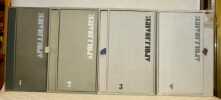
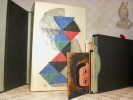



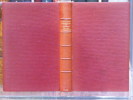




![Etudes et informations réunies par Michel Décaudin. [Apollinaire (Guillaume)] Décaudin (Michel ; dir.)](https://static.livre-rare-book.com/pictures/AVE/135234_1_thumb.jpg)


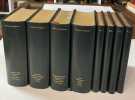

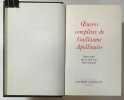
![La Rome des Borgia.. APOLLINAIRE (Guillaume) [et DALIZE (René)]](https://static.livre-rare-book.com/pictures/WLD/28770_1_thumb.jpg)
![La Rome des Borgia.. APOLLINAIRE (Guillaume) [et DALIZE (René)]](https://static.livre-rare-book.com/pictures/WLD/28770_2_thumb.jpg)





